Our holiday in the western part of Sicily was initially scheduled for the month of May 2021.
Due to the protracted restrictive measures for Covid-19, we had been forced to put our wishes in a drawer and postpone the trip for a year.
Compared with the original programme, however, we have made some adjustments.
Carefully analyzing the flight schedules and the days available to us, we have removed the visit of a few days to Palermo, which we will do calmly in the future.
Palermo in fact, with its priceless historical and artistic heritage, is not a city where you can just skim the surface and move on.
This is how a more sustainable itinerary was born, well structured in times and ways.
A mix of history, art and culture of one of the most beautiful areas of the region, passing through the tasting of typical products and a series of outdoor activities.
In this article we provide you with some ideas on how to organize your 7-day road trip in Western Sicily, as well as some practical information to better plan it in advance.
Table of Contents
- Arriving in Trapani: Tips and Transportation Options
- Accommodation in Western Sicily
- Road trip in Western Sicily, our itinerary
Arriving in Trapani: Tips and Transportation Options
For those of us traveling from abroad, the most convenient and cost-effective way to reach Trapani is by plane.
Trapani Birgi airport is located just over 15 kilometers away from the city’s historic center and can be easily accessed by car via the SP21 coastal road.
After quickly completing the customs procedures, we headed to the car rental office to pick up the vehicle that we had reserved online a few weeks before our trip.
In order to book it, we opted (as we always do) for DscoverCars, which we have always found to be reliable.
Their “free cancellation” option gave us the peace of mind that we could make changes if needed due to any last-minute unforeseen events.
However, if you don’t want to drive, there are other transportation options available as well.
You can take for example a bus from the airport directly to Trapani (or Palermo), or you can even book a private transfer by car or van for a more comfortable and convenient option.
Finding the Perfect Accommodation in Western Sicily
When it came to choosing accommodation for our trip to Western Sicily, we decided to do things a little differently from what we were used in the past.
Instead of staying in multiple places like we had done during previous trips, we opted for a single accommodation facility that would be centrally located and convenient for all the places we wanted to visit.
After studying the map carefully, we decided to book a stay at the Corte Olea Resort, which was equidistant to all the attractions on our itinerary.
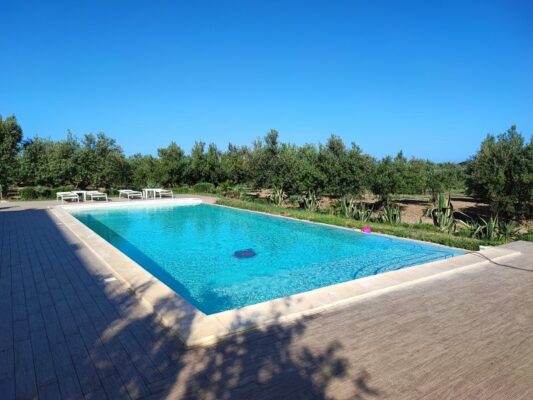
Corte Olea Resort
The resort is located in the town of Paceco, on the southern outskirts of Trapani and just 13 kilometers away from the airport.
It is nestled in a peaceful olive plantation and offers a wide range of rooms, an outdoor swimming pool, and a bar service.
For our stay, we opted for a spacious and comfortable apartment with a kitchenette, dining area, and a terrace with stunning views where we enjoyed our breakfast each morning.
If the Corte Olea Resort is fully booked for your desired dates, you can check out the following link to find other excellent accommodation options in Western Sicily.
7-day road trip in Western Sicily – our itinerary
For those who follow our blog, it’s no secret that we have a penchant for slow tourism that is focused on tradition and the enhancement of the territory.
Sicily, with its generous hospitality, is the perfect place to experience these emotions.
After setting up a logistics base in Paceco, we planned daily excursions that could be adjusted based on the moment’s sensations.
Given the limited time, we made specific choices about the places to visit in western Sicily, leaving out destinations such as Mazara del Vallo, the island of Favignana, and the entire southern area from Selinunte to Sciacca.
Thankfully, we enjoyed beautiful sunny days with pleasant evening breezes that alleviated the already high temperatures for the spring season.
Day 1 – Segesta and Erice
On Day 1 of our 7-day itinerary in western Sicily, we began our exploration of the region with a visit to the ancient city of Segesta.
Nestled in a picturesque valley filled with meadows, olive groves, and Mediterranean shrubs, Segesta is a must-see for history buffs.
It was the primary center of the Elimi, a people believed to have originally hailed from Greece and who settled in Sicily during the Bronze Age.
Segesta was among the first Sicilian cities to ally with Rome during the First Punic War, and it was a fierce rival of Selinunte, a Greek colony located on the island’s southwest coast.
In 409 BC, the two cities engaged in a violent battle, with Segesta ultimately emerging as the winner.
To reach the archaeological park of Segesta, take the A29 Trapani-Palermo motorway and exit at the Segesta junction.
From there, turn left and park your car at a dirt clearing a short distance away from the entrance.
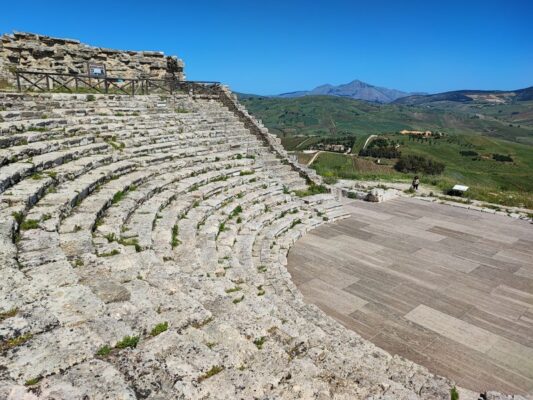
Theatre of Segesta
Undoubtedly the main attraction of Segesta is its ancient temple, which dates back to the fifth century BC and stands as one of the best-preserved examples of Doric architecture in the world.
Visitors can reach the temple via a short climb with steps that are approximately 250 meters long, flanked by stunning agave plants.
The agora and theater are situated at the top of Mount Barbaro, accessible either by shuttle bus for a fee or on foot via a 1.5-mile uphill route along a paved road that has some hairpin bends and sensitive slopes.
Along the way, there are natural viewpoints where visitors can take a break, relax, and enjoy the breathtaking view.
We recommend taking the shuttle bus, particularly during hot summer days.
The archaeological areas are surrounded by rosemary, broom, cacti, wild plants and wild garlic, which lend a colorful backdrop to the sites.
While there are few remaining traces of the agora, the theater is exceptionally well preserved and dates back to the third century BC.
It is semicircular in shape, oriented towards the north, perhaps to allow the audience to appreciate the stunning view that stretches all the way to the sea.
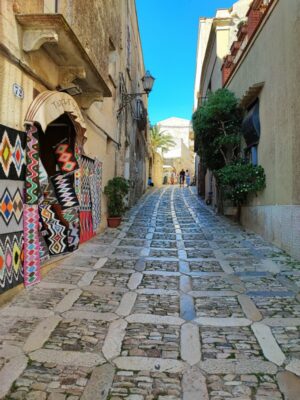
Erice
In the afternoon, we decided to explore the enchanting village of Erice.
This triangular-shaped village is situated at an altitude of 751 meters on the mountain formerly known as Monte San Giuliano, which was home to a renowned sanctuary dedicated to the goddess of fertility, the protector of sailors.
Erice was considered a sacred city by the Elimi people.
It is like an open-air museum that is perfect for slow tourism. It should be discovered at a leisurely pace by strolling through the paved alleys and admiring the various religious buildings, each more stunning than the last.
Erice is easy to explore independently, as we did, or with a guided tour from Trapani that includes transportation services and a tasting of local products.
The guided tour lasts about three and a half hours, and the guide speaks English.
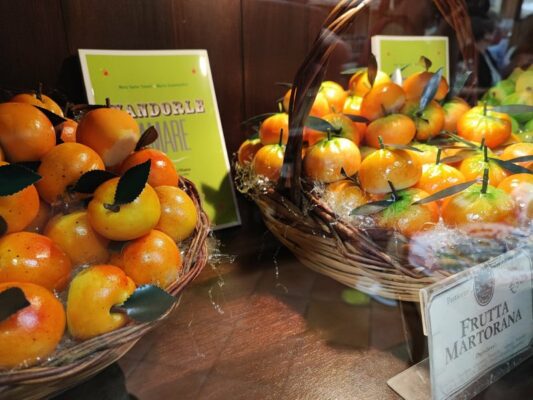
Frutta Martorana, Pastry Chef Maria Grammatico
Regarding our in-depth experience, we invite you to check out our dedicated article on what to see in Erice in one day.
Also, don’t miss out on the opportunity to stop by Maria Grammatico’s famous pastry shop before leaving the village.
You can indulge in a variety of delightful treats such as cannoli stuffed with ricotta, cassate with almonds, martorana fruit, Genoese cake and more.
Day 2 – Levanzo
On the second day of our seven-day itinerary in the western part of Sicily, we embarked on a journey to Levanzo, the smallest island in the Egadi archipelago.
As we highlighted in our article dedicated to the island, Levanzo is a place that captivates and steals the heart.
It is located six nautical miles from the coast and can be conveniently accessed by hydrofoil from Trapani, taking approximately 50 minutes with a stopover in Favignana.
For a hassle-free summer visit, we highly recommend booking your ticket in advance through Liberty Lines’ website.
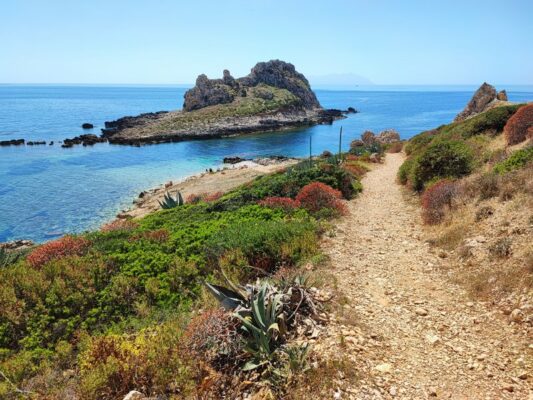
Cala Faraglione, Levanzo Island
While many visitors only make a brief stop on the island, others opt for mini cruises to Levanzo and Favignana organized by agencies and private companies.
We, however, recommend to dedicate at least a complete day to Levanzo in order to fully appreciate its extraordinary beauty.
An exclusive visit will give you the opportunity to explore places of extraordinary beauty like the Grotta del Genovese, a historical and artistic treasure, the beaches nestled in charming coves, and the crystal-clear waters of the sea.
Day 3 – Marsala
To be honest we didn’t have high expectations for Marsala, but it turned out to be a pleasant surprise.
We still remember the elegant buildings with their ochre facades, which shone golden under the sunlight.
The city itself also boasts a rich cultural and artistic heritage in its historic center.
We recommend parking near the Teatro Impero, where there are free spaces available.
The name “Marsala” has Arabic roots (marsa or port of Ali), but the original settlement date back to the Phoenician era.
Despite its Roman layout, the city features monuments influenced by the Swabian, Norman, and Angevin periods.
Start your visit along the seafront, admiring the monument dedicated to the expedition of the Thousand (a milestone during the Italian unification process), then enter the historic center through Porta Garibaldi.
Just beyond the entrance, rebuilt in 1685 and formerly known as Porta del Mare, you’ll find many interesting buildings to explore.
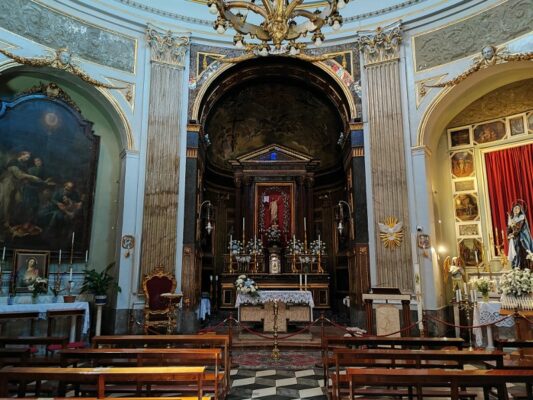
Sanctuary of Our Lady of Sorrows
One side of the city center features the ancient market complex where fish stalls are now located, while on the other side stands the circular-shaped Sanctuary of Our Lady of Sorrows.
The sanctuary is one of the most popular religious buildings for locals, with a dome covered in bright green majolica, reminiscent of those found in Central Asian mosques.
The center’s pedestrian streets are elegant, paved with polished stone tiles that reflect light.
Walking along Via Giuseppe Garibaldi, visitors can see a continuous flow of clubs, shops, and restaurants before reaching Piazza della Repubblica, which is the city’s beating heart.
This rectangular square houses the Duomo, constructed between the seventeenth and eighteenth centuries, dedicated to St. Thomas of Canterbury, and the Palazzo VII Aprile, also called the Palazzo dei Giurati, which currently serves as the seat of the City Council.
Leaving the historic center after Porta Nuova, you can reach the archaeological park in just a few meters.
In ancient times, the survivors of the town of Motya poured into the city of Lilybaeum (nowadays Marsala) after their island’s destruction by the tyrant of Syracuse, Dionysius, in 397/6 BC.
The park’s museum houses an impressive collection of artifacts, including the remains of a Punic ship discovered off the coast of the nearby Mozia Island.
The ship sank on its way home after engaging in a battle against the Carthaginians in the waters of the Egadi.
Scholars confirmed its Punic origin, as the Phoenician-Punic alphabet was painted and engraved on the hull.
A visit to Marsala wouldn’t be complete without indulging in the local cuisine.
The region is renowned for producing one of Sicily’s most famous and valuable wines, the Marsala. Don’t miss the chance to savor the authentic flavors of the area.
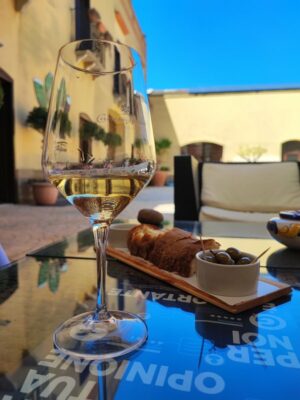
Cantina Caruso e Minini
Like other fortified wines, Marsala was introduced to the world by John Woodhouse, an Englishman from Liverpool who arrived in the city in the late 18th century.
Impressed by the wine’s excellent flavor, Woodhouse exported it to England, where it was highly appreciated by noble families and entrepreneurs alike.
To prevent the wine from deteriorating during the long journey, he added pure alcohol to it.
Marsala is produced using white grape varieties such as Grillo, Catarratto, Ansonica, and Damaschino, or black grapes like Nero d’Avola, Perricone, and Nerello Mascalese.
There are many companies offering wine tastings and sensory experiences, ranging from renowned and well-established brands to family-run businesses.
Following the wine tasting, we drove to the outskirts of the city, to Contrada Santo Padre delle Perriere, where we discovered one of the most remarkable places we have ever seen: the Caseificio in Cava Impiccichè.
Note that unfortunately the website is available only in italian.
This unique structure is situated in a tuff quarry that has been transformed into a garden, and produces a wide range of cheeses made exclusively from raw milk obtained from 800 Belice sheep.

Dairy in Cava Impiccichè
The Belice sheep flock roams in a semi-wild state over a vast property of around sixty hectares.
At the shop, you can browse through three distinct product lines: the counter, the traditional, and the gourmet.
Mr. Giovanni, the owner, greets customers and visitors with an infectious enthusiasm and welcomes them with open arms.
When you arrive at the property, you can either park your car at the top or take a walk down to the quarry.
Day 4 – Salt pans of Trapani and Paceco – Island of Mozia – Salt pans of Marsala
Day 4 of our travel itinerary took us along the stunning coastline between Trapani and Marsala, with a jam-packed schedule of visits to the salt pans, as well as an excursion to the charming Island of Mozia for a few hours.
The salt pans of Trapani-Paceco and those of Marsala are two different locations, roughly twenty kilometers apart.
Which one to choose? Well, that really depends on your tastes and interests.
If you are a nature lover, then the Trapani-Paceco salt pans are the perfect spot for you.
On the other hand, the Marsala salt pans are more geared towards tourists, with a wide range of attractions to keep visitors entertained.
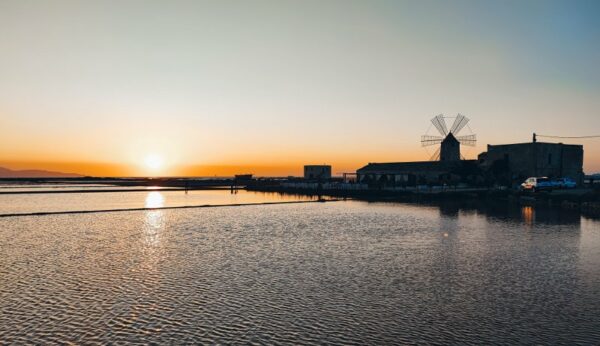
Salt pans of Trapani and Paceco
We highly recommend visiting both the salt pans of Trapani-Paceco as well as the ones in Marsala.
While we personally preferred the former, both offer unique experiences that are definitely worth checking out.
To explore the salt pans of Trapani-Paceco, there are guided tours available from Trapani that last a couple of hours.
The tours include transportation, a guided visit, a tasting of local products, and entrance to the Salt Museum in the outskirts of the village of Nubia.
Mozia, on the other hand, is a place that truly captures the heart.
The island of San Pantaleo, also known as ancient Mothia, has been inhabited since prehistoric times.
It’s located about ten kilometers north of Marsala and, along with the islands Grande or Lunga, Schola, and Santa Maria, forms the Reserve of the Lagoon of the Stagnone.
To get there, you can take a short boat ride that’s offered by various companies.
You’ll find the boarding area well-marked along the SP21 coastal road.
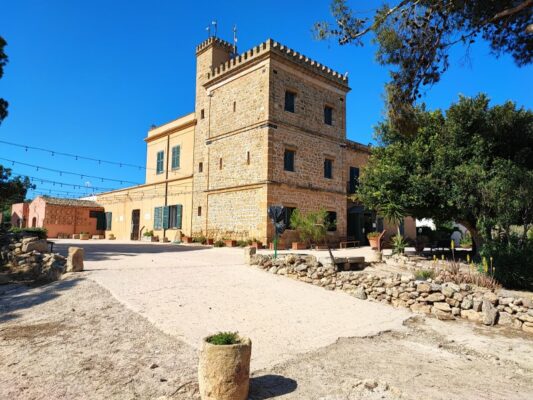
Whitaker building, Mozia
The southern shore of the island has been a strategic point on the Mediterranean trade routes since the eighth century BC when the first Phoenician settlement was established.
Mozia’s location in a lagoon made it challenging for enemies to conquer, as one had to know the channels and currents well to avoid running aground.
The middle of the sixth century BC saw Mozia surrounded by walls, with several monuments built, and it reached its peak. However, as we mentioned earlier, it was destroyed by Dionysius in 397/6 BC.
Mozia’s rediscovery was thanks to Joseph Whitaker, a member of a wealthy English family who conducted business in Sicily and fell in love with this fascinating place between the late nineteenth and early twentieth centuries.
During those times the island was inhabited by farmers who, while working in the vineyards, discovered archaeological artifacts and delivered them to Whitaker.
In the early twentieth century, the British ornithologist purchased the island, and it was bequeathed to his daughter.
She donated it to the homonymous foundation in 1971 after her father’s death.
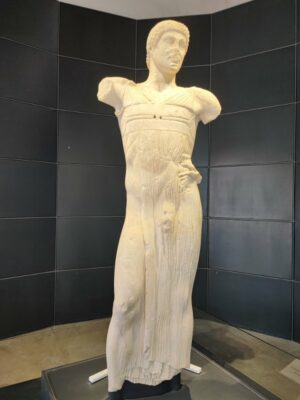
Young man from Mozia
To access the island of Mozia, visitors must pay an admission fee that includes access to the Mozia museum.
We highly recommend starting your visit with the museum, housed in the former residence of Joseph Whitaker.
Here, you can view a collection of artifacts that includes the notable Young Man of Mozia sculpture.
This male figure is dressed in a long tunic and held at the chest with a wide band featuring central holes.
Discovered in 1979 under a pile of debris, it is estimated to date back to the second quarter of the fifth century BC.
After exploring the museum, we suggest following the map provided at the entrance to embark on a leisurely walking tour of the island.
Along well-marked paths, visitors can immerse themselves in the peaceful surroundings and discover the island’s treasures.
Take your time and enjoy the moment without any time constraints.
Mozia is truly a place where visitors can lose themselves in the sensations of the island.
Day 5 – Trapani
On Day 5 of our trip, we arrived in Trapani, a city that had captured my heart since 2005, when I watched the sailing regattas in preparation for the America’s Cup on TV.
The water between the city and the Egadi Islands was the stage for a series of match races for the Louis Vuitton Acts, and the contrast between the ochre buildings and the blue sea left a lasting impression on me.
Trapani is a city that needs to be explored at a leisurely pace, and it’s worth returning at different times of the day to appreciate its beauty in different lighting.
We started our visit to the historic center from the monument to Giuseppe Garibaldi, situated on the promenade Viale Regina Elena, and wandered through its narrow streets, which are paved with polished stone.
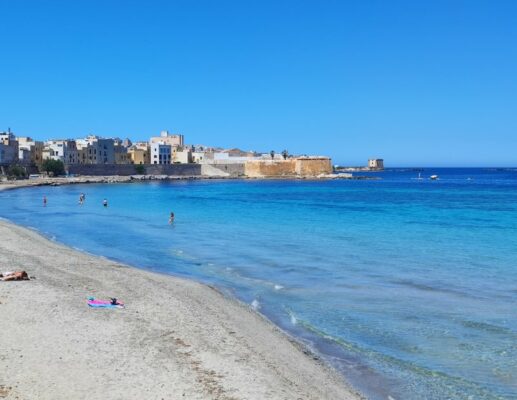
The beach of the Walls of Tramontana
For those interested in history and architecture, the old core of Trapani is a must-visit.
Take a stroll and appreciate the religious buildings and elegant palaces that make up the city’s rich cultural heritage.
One notable landmark is the Palazzo Senatorio, located on the site where the Loggia dei Pisani once stood.
This fifteenth-century palace was renovated in the seventeenth century and boasts a Baroque-style façade with three orders.
In 1828, two boxes were added to display the clock and date. Today, it serves as municipal offices.
Another must-see is the Cathedral of San Lorenzo. Originally built in 1102 as a chapel of the Genoese, it underwent expansion in the fifteenth century.
The cathedral was completely renovated in 1639, and in 1743, architect Giovanni Biagio Amico added the current façade with pronaos and portico, as well as the bell tower, dome, side chapels, and choir.
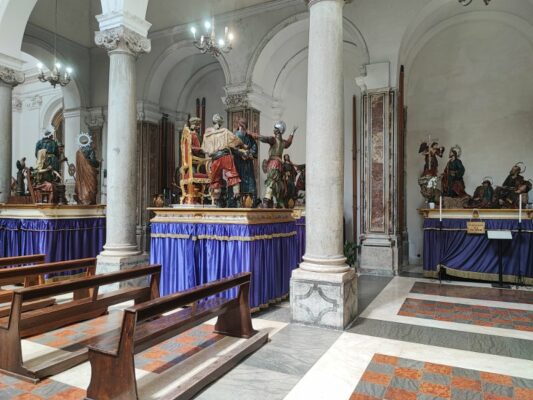
Mysteries of Trapani
The Church of Purgatory is a remarkable religious building that was erected in 1688 by the esteemed architect Pietro Castro.
The church boasts a floor plan that is composed of three naves and the interior is designed in the shape of a Latin cross.
It is adorned with twenty sculptural groups of the Mysteries, which poignantly evoke the Passion of Christ.
These works are carried in procession during the Holy Week celebrations. Created between the seventeenth and eighteenth centuries, they were produced in the city’s craft workshops using the age-old technique of wood, canvas, and glue.
Day 6 – Zingaro Reserve – Scopello – Castellamare del Golfo
For day six of your itinerary, we recommend a challenging yet rewarding excursion that offers a beautiful mix of natural landscapes and the sea.
Our morning was spent trekking in the Zingaro Nature Reserve, a protected area located along the west coast of Sicily between Scopello to the south and San Vito lo Capo to the north.
During the summer we recommend visiting the reserve in the morning when the temperature is still comfortable for walking.
The trekking trails here provide stunning views of the coastline and natural environments.
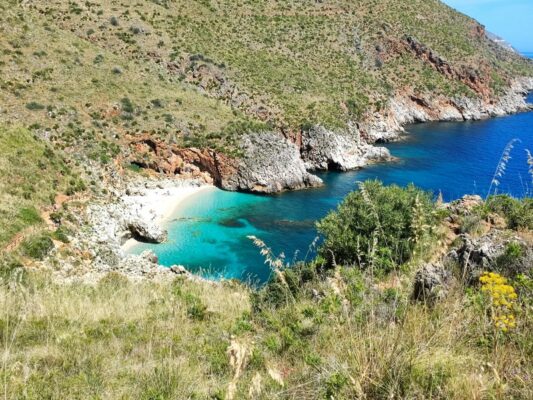
Cala della Capreria, Zingaro Nature Reserve
The Zingaro Nature Reserve, which was officially established by the Regional Law 98/1981, was the first reserve in Sicily to be managed by the regional body.
We highly recommend a visit to this reserve to everyone, regardless of whether you’re a nature lover or a trekking enthusiast.
The reserve can be accessed through two main entrances: one on the Scopello side and the other on the San Vito lo Capo side.
However, please note that there is no direct road connecting the two entrances.
Scopello, a small village with a rich history and a charming atmosphere, is built around an eighteenth-century baglio.
In the Sicilian tradition, a baglio is a rural complex that is enclosed by walls and features an internal courtyard.
After savoring a cup of coffee or a refreshing granita at one of the restaurants in the center, we recommend taking a stroll down to the sea.
Here you will find the famous Faraglioni Beach, surrounded by ancient towers and an old tonnara.
The beach has also been featured in an episode of the popular italian TV series, Commissario Montalbano.
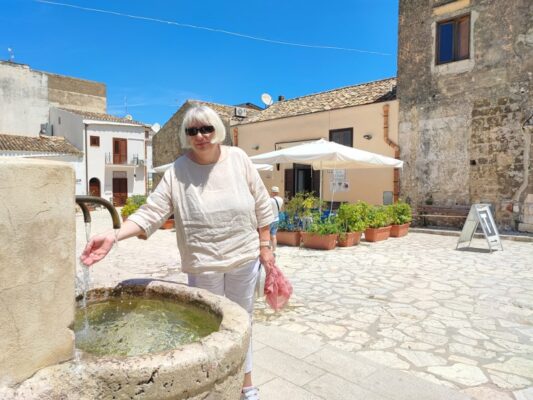
Scopello
About 10 kilometers downstream on a gentle slope lies Castellammare del Golfo, which was established as a port for the city of Segesta by the Elimi.
The town was founded in the mid-sixteenth century, while the first castle dates back to the time of the Saracens.
The fortress, located on a small promontory next to the port, was remodeled by the Normans and Swabians and later rebuilt by the Aragonese in the 14th and 15th centuries.
In the square in front of the complex stands the church of the Rosary, featuring a 16th-century portal, while behind it is the Mother Church.
If you don’t have a car, you may want to consider a guided tour of San Vito lo Capo, Scopello, and Castellamare del Golfo, departing from Trapani.
This 9-hour excursion offers a mix of history, culture, sea, and culinary experiences that you won’t forget.
Day 7 – San Vito lo Capo – Macari
We suggest to fully dedicate the last day of the trip to explore the stunning beaches of western Sicily.
Our first stop is San Vito lo Capo, a charming seaside destination that can be reached through a scenic avenue lined with towering palm trees.
The village itself is a lattice of white buildings with terraced roofs, and its streets lead to the picturesque seafront.
With its crystal-clear waters and pristine sand, San Vito lo Capo is the perfect place to soak up the sun and enjoy a refreshing swim.
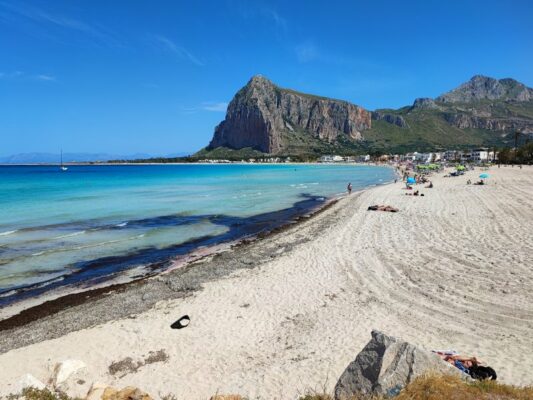
The beach of San Vito lo Capo
The crescent-shaped beach with fine white sand is one of the main attractions of San Vito lo Capo.
The marina and lighthouse to the north and the impressive Monte Monaco to the south border it.
The sea has crystal-clear turquoise waters, which are perfect for swimming and water activities.
The Sanctuary of San Vito, a fortress-like structure dating back to the thirteenth century, has been a place of pilgrimage since ancient times.
It gained fame for the church and miracles attributed to the martyr Vito.
On the way back to Trapani, we recommend stopping at Macari, just a few kilometers south of San Vito.
The bay of Macari is a beautiful natural inlet nestled between Monte Cofano and San Vito.
Spend a few hours here enjoying the scenic views and relaxing by the water.
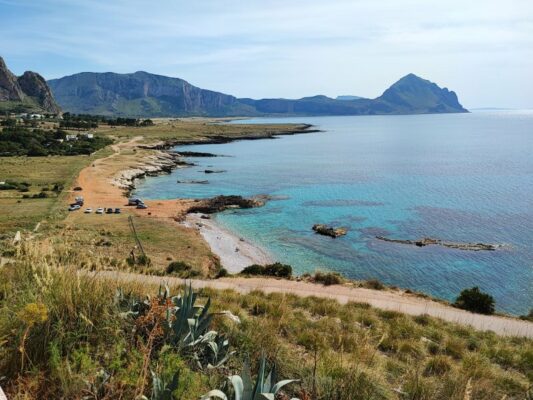
Gulf of Macari
It boasts a wild beach. Notable coves include Baia Santa Margherita, Isulidda, and Rosa.
One of the most stunning places to visit is the Cala del Bue Marino, which was awarded as Italy’s most beautiful beach by Legambiente in 2015.
The pebble beach is popular among sunbathers and photographers who capture breathtaking shots at sunset.
Our 7-day road trip in Western Sicily ends here.
While we could not include all the fascinating places of interest in a single holiday, we believe that this itinerary covers a good selection of what the region has to offer.
It is essential to allow enough time to enjoy each destination fully.



0 Comments